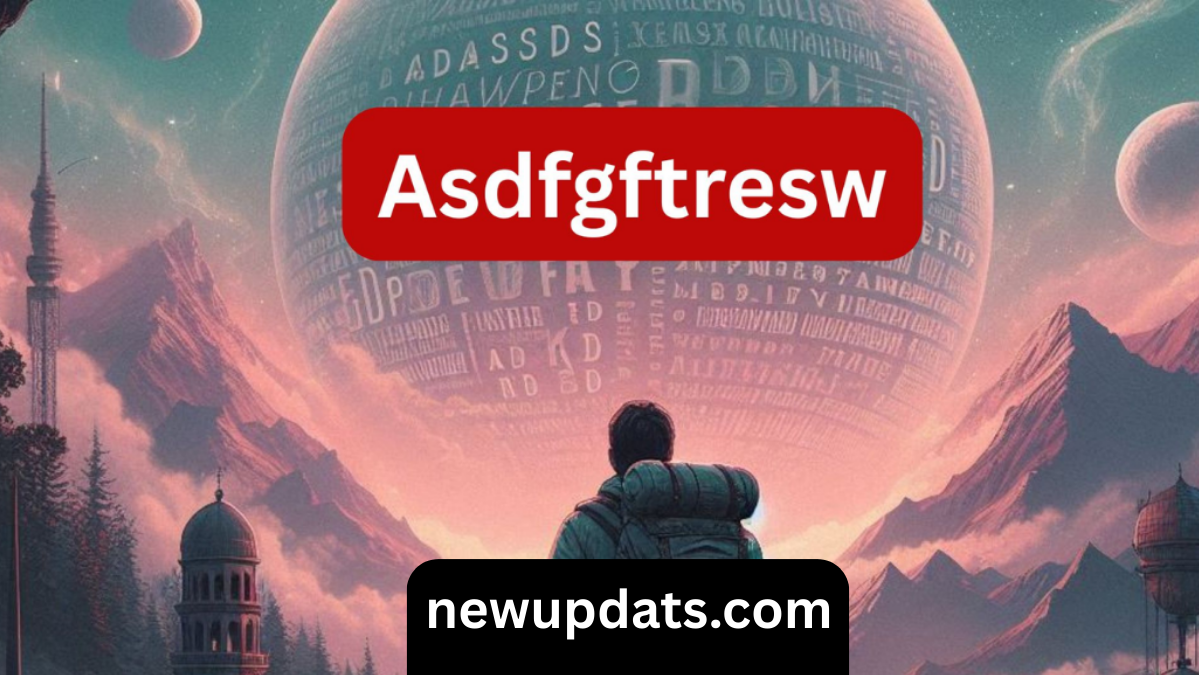1. What on Earth Is asdfgftresw?
Let’s begin by acknowledging the elephant in the room: asdfgftresw is not a standard term you’ll find in the dictionary—or, let’s face it, anywhere else. It’s a quirky string of letters that begs the question: what could it represent? For our purposes, we’ll treat asdfgftresw as a placeholder name for an innovative framework, model, or methodology—an exploratory vessel if you will—floating in the wild sea of creative ideas.
With that out of the way, every groundbreaking concept needs a backstory. Imagine that asdfgftresw originated in a think tank somewhere between tech labs and coffee shops, where thinkers scribbled code, diagrams, and theories onto half‑drunk lattes and napkins. It embodies the spontaneity of innovation, the messy genius of brainstorming, and the potential for world‑changing ideas born from randomness—or so we like to think.
In other words, asdfgftresw is a canvas. It’s a term you can stamp whatever meaning onto, and that opens up endless possibilities. We could define it as a framework for creative ideation, a paradigm for emergent-learning systems, or a metaphor for modern innovation. The beauty lies in its blankness—it’s a vessel ready to be filled.
2. Origins and Conceptual Foundations of asdfgftresw
So where might asdfgftresw have come from, logically speaking? Let’s speculate, like a historian piecing together breadcrumbs for a brand‑new civilization. Imagine a cross-pollination of disciplines—linguistics, systems theory, cognitive science—spun together in the chaotic whirl of an idea lab.
Perhaps linguists tossed random letter strings into algorithms to test neural nets’ pattern‑recognition capabilities. Meanwhile, a systems theorist noticed interesting emergent properties whenever repeated random strings were used as test tokens. And thus, asdfgftresw was born—not as meaningful data, but as a seed for discovery.
This oddball string could become a stand‑in for complex system behavior analysis, a testbed for learning patterns, or a placeholder in UX prototypes. Over time, those prototypes, tests, and experiments grew more intricate and considered—and the unassuming asdfgftresw became a beloved shorthand in internal documentation. It’s the codeword for “try and see what happens”—a champion of experimentation.
From another angle, we could frame asdfgftresw as a conceptual tool: a symbol of the creative act itself. It suggests “here are letters, but what can they become?”—much like painting arbitrary brush strokes and seeing what shapes emerge. That invites fluidity and openness, both critical to genuine innovation.
3. The Structure Behind asdfgftresw: Imagining Its Framework
Even a whimsical term needs structure to be useful. So let’s design imaginary—but compelling—components for asdfgftresw. We’ll treat it as a framework with three core pillars: Chaos, Feedback, and Refinement.
Chaos
First, chaos matters. Every project starts with unstructured energy—raw inspiration, randomness, whimsical doodles, half-formed sentences. asdfgftresw revels in that chaos. It says: toss strings of letters, scribble in the margins, brainstorm half-baked notions. That’s the creative ignition moment. Embracing chaos is essential because true innovation often sprouts from disorder, not rigid planning.
Take any breakthrough idea you’ve encountered—probably it didn’t begin with a perfectly structured outline. It began with scribbles on a napkin—or was a byproduct of letting ideas collide. asdfgftresw canonizes that messy beginning as its sacred first step.
Feedback
Second, feedback enters the stage. Once chaos births a nascent idea—like our fictional string of letters—it needs reflection. That’s where testing, cracking open prototypes, gathering reactions, and iterating come in. Imagine running user tests, or even peer reviews, where the “asdgftresw” stands in for a concept that’s half-baked.
Those external inputs help shape the chaos into something more coherent: what stands up to questioning? What resonates? What falls flat? This is the iterative enhancement phase, where we refine, discard, rebuild. We call this pillar “feedback”, and it transforms the raw material into something with staying power.
Refinement
Third, refinement. Now that feedback has guided us, we move into polishing, structuring, and formalizing. You distill the essence, document the methodology, define protocols. If asdfgftresw were a new design pattern, this is where you create the style guide, write the sample code, and write the blog post or whitepaper.
The goal: make it replicable, scalable, communicable. You go from scribbles to structured outline, from joke code to library importable, from stray idea to taught curriculum. That three‑pillar model—Chaos, Feedback, Refinement—gives asdfgftresw its robust internal architecture.
4. Applying asdfgftresw: Real‑World Use Cases (Fictional but Believable)
Now, let’s get practical—even if we’re mostly just weaving a plausible fiction. How might asdfgftresw show up in actual work?
Innovation Labs and R&D Teams
Picture an R&D team at a tech company, drowning in pressure to deliver breakthrough products. They could adopt asdfgftresw as their ritual: spend the first week scribbling nonsense, throwing any half-cooked idea on the whiteboard (Chaos), then run quick internal demos (Feedback), then choose a promising thread and formalize it into a prototype (Refinement). Over time, asdfgftresw-sessions become a brewery of raw ideas turned into real pilots.
Design Workshops and Creative Training
Next, consider creative workshops. Designers and copywriters sometimes get stuck holding their own process hostage to structure. Someone could introduce asdfgftresw as a warm‑up: “Write me a random word like asdfgftresw, then create a concept around it—sketch how it feels, what it could be, how you’d pitch it.” That playful absurdity often gets the brain out of the rut. Then they present to peers (Feedback) and shape it into a fun campaign (Refinement).
Education and Ideation in Classrooms
Finally, schools and universities might use asdfgftresw in creativity classes. Students could be given an assignment: invent your own “shock term”—call it asdfgftresw—and write a short essay defining what it is, how it works, its use. Then classmates evaluate (Feedback), and the author revises (Refinement). It teaches ideation, iteration, and the creative cycle in a memorable, absurdly fun way.
5. Why asdfgftresw Works: The Psychology of Blank‑Canvas Terms
This might seem silly—why use a nonsensical term rather than a meaningful one? Here’s why, explained from a psychological and design standpoint:
Disarming Familiarity
A familiar term carries baggage—expectations, definitions, pre‑conceptions. But a blank‑canvas word like asdfgftresw frees us from that. We’re not restricted by what “innovation,” “ideation,” or “prototype” might imply. It’s clean, neutral, and invites projection. Participants bring their own imagination, not boxed‑in definitions.
Encouraging Play
Humor and play lighten the creative process. Saying, “Let’s workshop asdfgftresw” immediately invites a chuckle. That small release of tension can unstick creative blocks. It paves the way for more daring, experimental thinking. Playfulness is a superpower in ideation—and asdfgftresw is, in essence, a playful device.
Embracing the Unknown
Creativity thrives in the zone of not knowing. Your mind relaxes enough to roam, to imagine, to build new neural connections. A nonsensical anchor term like asdfgftresw signals “we don’t know what this is yet,” which is exactly the invitation creatives need to wander into new territory.
6. Structuring asdfgftresw Workshops: Practical Guidelines
If you want to actually run a asdfgftresw session—or something modeled on it—here’s how you might organize it in the real world:
Phase 1: Chaotic Seeding (15–30 minutes)
Kick off with random input: strings of letters, mismatched images, odd sound clips. Invite participants to just freestyle. “Don’t edit, don’t judge, don’t explain—just let your mind spit things out.” Capture every idea without filtering. That’s your Chaos zone.
Journalists call that step “first thought, best thought.” It’s messy, but pure. Encourage scribbles, doodles, nonsense paragraphs, or spoons in place of ideas.
Phase 2: Peer Feedback Bounce (30–45 minutes)
Once you have a heap of raw thoughts, let’s put them out there. Break into small groups, each presenting a nugget. Others ask questions: “What do you see? What does it remind you of? What could that become?” That’s your Feedback zone. It’s not about judging, but curious exploration.
Keep ground rules light: no idea is wrong, every response starts with “Yes, and…” or “Have you considered…?” The goal is to spark, not shut down.
Phase 3: Refinement Sprint (45–60 minutes)
Pick a few ideas that sparked real energy. Now shape them. Ask: “What could this become? Who is it for? What’s its name? How would you prototype it?” Add structure: one‑pager sketches, mockups, quick mock pitch. That’s the Refinement zone.
Wrap up by presenting polished seeds that began as nonsense and now have form. Celebrate that journey—it models the power of creative systems.
7. Evaluating asdfgftresw’s Strengths and Limits
No framework is perfect. Here’s a balanced look at what asdfgftresw brings to the table—and what it might struggle with.
Strengths
- Friction reduction: The playful nonsense lowers pressure for perfection.
- Idea generation: Gives permission to be weird—and weirdness often births breakthroughs.
- Adaptable structure: The three‑phase scaffold works across disciplines: product, writing, marketing, learning design.
Limits
- Getting lost: Without experienced facilitation, chaos can stay messy and unproductive.
- Resistance to abstraction: Very practical people may mock or dismiss the nonsense—”Let’s get real” could be their instinct.
- Time constraints: In pressured environments, teams may skip Chaos and shrink Feedback, losing core value.
To do asdfgftresw well, you need a trusted guide. You need champions who hold space for absurdity and guard against early closure. It’s a framework that demands patience and tempering—but the payoff can be real.
8. Lessons Learned and Expert Tips for Using asdfgftresw
Here are pro-level insights if you’re going to run your own asdfgftresw-style process:
- Begin with acceptance
Make clear: every idea is welcome. The more ridiculous, the better. Discomfort is part of the creative process. - Use visible recording
Whiteboards, sticky notes, digital scribbles—all visible matter. The more people see, the more they jump in or build. - Rotate observers
Sometimes participants can bounce off by shifting roles. Have others observe and feed insights later; that resets perspectives. - Bring real constraints later
Keep chaos unstructured—but in Refinement, introduce constraints: time, budget, audience, platform. That makes ideas actionable. - Celebrate micro‑wins
Even a half‑formed idea nurtured into a slide or a tweetable phrase is progress. Recognize progress, not just polished final products.
9. Case Study (Imagined) of asdfgftresw in Action
Let’s play make-believe with a case. (It’s entirely fictional—but believable.)
Company: ZenoTech, a mid‑sized firm stuck in incremental improvements.
Challenge: Create a bold new product direction.
Action: ZenoTech adopted the asdfgftresw ritual. Senior leaders spent a day café‑style scribbling random strings, prompting ideas that were absurd—the “solar‑powered sock dryer,” “whispering mirror” concept, “emotion-reading coffee mug.”
Then teams did feedback rounds: “What emotion does the mug evoke?” “Could the mirror be art piece or smart device?” Then refined one concept: “Whispering mirror”—a mirror that gives mood‑boosting affirmations using voice and lighting. They sketched an MVP, tested with a few staff, iterated the script.
Outcome: A modest pilot project and an internal brand “We dare with asdfgftresw” to encourage future bets. Culture changed—they started trusting the absurd as a path to insight.
10. Final Thoughts: Embracing the Unseen Power in asdfgftresw
There’s something magical about nonsense—about words that carry no weight, yet open all doors. asdfgftresw isn’t about the letters themselves—it’s about what they stand for: uninhibited curiosity, playful experimentation, and spiral‑to‑substance transformation.
If you ever feel stuck—or too weighed down by expectations—consider borrowing asdfgftresw as your secret weapon. Let the nonsense in. Let it seed. Invite feedback. Shape it. Watch how it blooms.
After all, every great idea often begins as a whispered something‑nonsense. asdfgftresw is just the tag to remind us: creative magic starts with letting go, scribbling wildly, and trusting that something real will take shape.




